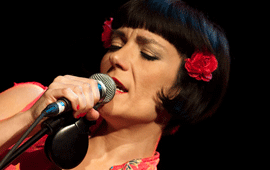> [Archived] Chronicles

Hispanic Passion
Let us take it step by step and explain it leisurely. To start with, we need to mention that the music which the four musicians interpreted was a combination between classical flamenco and modern rhythms - rock, punk, blues and even rap. Tradition is entwined with novelty, without there being a disaccord between them. There are no distinct notions, but together they constitute a common, organic and homogenous corpus.
Chant, dance, drama, passion, implication, tradition, novelty
The four musicians presented a repertoire which has its roots in tradition - in the flamenco whose perfume probably originates from under a searing sun. Elsa Rovayo's voice follows the volutes of this chant extending in a pursuit filled with longing, melancholy, but also with passion. It is a round voice that does not necessarily need amplification. She demonstrated it in the encore, when the singer stepped off the stage and sang from the audience, with the same conviction, with the same coherence and passion. Her voice keeps the same virtues even when the rhythms accelerate and they change from old to new and unconventional.
Elsa Rovayo's danceis the authentic one, the one which we admire in Spanish films. Spectacular, electrifying, oscillating between force and elegance. On the other hand, one should know that dancing was part of the artist's life before singing. Up to the age of 15 she studied at every flamenco school from her hometown - Ceuta - and afterwards, when she was 17, she gained her living by dancing in flamenco clubs in Madrid. It is hard to describe the tension and the grace, the broken movements that unfold into mild arches, the speed of the small steps doubled by the sound of the castanets, alternated by a lazy step, that barely touches the floor, the tension that is entwined with the loosening. The drama and the passion of a culture are mirrored in this dance, in that the most important element is the balance and the exactness of the next step.
In this blend of tradition and novelty, the audience was greatly implicated. If flamenco, in all its forms, is meant to seduce, then La Shica and her three stage partners certainly managed to do it. The artist offered explanations between the songs and, in the end, the show even became interactive: the audience had the occasion to sing along the artist; admittedly, only two lines that were the answer to her chorus. Even if they were at first a bit reserved at this proposition, the public was easily convinced by the assuredness of the artist: 'I am the boss here so you have to do as you are told' said she humorously, finally convincing us to participate at this game.
With such a promising start we can only be happy that the Classic Flamenco and its New GenresFestival lasts until the end of the month, more exactly until 26th March, the date to which it offers shows that deserve our full attention.
Translated by Izabella Feher
MTTLC, Bucharest University














